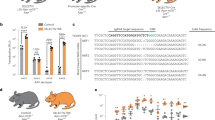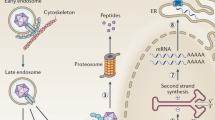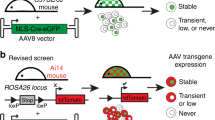Abstract
Understanding the process of vector transduction has important implications for the application and optimal use of a vector system for human gene therapy. Recent studies with vectors based on adeno-associated virus type 5 (AAV-5) have shown utility of this vector system in the lung, central nervous system, muscle and eye. To understand the natural tropism of this virus and to identify proteins necessary for AAV-5 transduction, we characterized 43 cell lines as permissive or nonpermissive for AAV-5 transduction and compared the gene expression profiles derived from cDNA microarray analyses of those cell lines. A statistically significant correlation was observed between expression of the platelet-derived growth factor receptor (PDGFR-α-polypeptide) and AAV-5 transduction. Subsequent experiments confirmed the role of PDGFR-α and PDGFR-β as receptors for AAV-5. The tropism of AAV-5 in vivo also correlated with the expression pattern of PDGFR-α.
This is a preview of subscription content, access via your institution
Access options
Subscribe to this journal
Receive 12 print issues and online access
$209.00 per year
only $17.42 per issue
Buy this article
- Purchase on Springer Link
- Instant access to full article PDF
Prices may be subject to local taxes which are calculated during checkout






Similar content being viewed by others
References
Bantel-Schaal, U., Delius, H., Schmidt, R. & zur Hausen, H. Human adeno-associated virus type 5 is only distantly related to other known primate helper-dependent parvoviruses. J. Virol. 73, 939–947 (1999).
Chiorini, J.A., Kim, F., Yang, L. & Kotin, R.M. Cloning and characterization of adeno-associated virus type 5. J. Virol. 73, 1309–1319 (1999).
Chiorini, J.A., Yang, L., Liu, Y., Safer, B. & Kotin, R.M. Cloning of adeno-associated virus type 4 (AAV4) and generation of recombinant AAV4 particles. J. Virol. 71, 6823–6833 (1997).
Muramatsu, S., Mizukami, H., Young, N.S. & Brown, K.E. Nucleotide sequencing and generation of an infectious clone of adeno- associated virus 3. Virology 221, 208–217 (1996).
Rutledge, E.A., Halbert, C.L. & Russell, D.W. Infectious clones and vectors derived from adeno-associated virus (AAV) serotypes other than AAV type 2. J. Virol. 72, 309–319 (1998).
Xiao, W. et al. Gene therapy vectors based on adeno-associated virus type 1. J. Virol. 73, 3994–4003 (1999).
Gao, G.P. et al. Novel adeno-associated viruses from rhesus monkeys as vectors for human gene therapy. Proc. Natl. Acad. Sci. USA 99, 11854–11859 (2002).
Qing, K. et al. Human fibroblast growth factor receptor 1 is a co-receptor for infection by adeno-associated virus 2. Nat. Med. 5, 71–77 (1999).
Mizukami, H., Young, N.S. & Brown, K.E. Adeno-associated virus type 2 binds to a 150-kilodalton cell membrane glycoprotein. Virology 217, 124–130 (1996).
Summerford, C., Bartlett, J.S. & Samulski, R.J. AlphaVbeta5 integrin: a co-receptor for adeno-associated virus type 2 infection. Nat. Med. 5, 78–82 (1999).
Summerford, C. & Samulski, R.J. Membrane-associated heparan sulfate proteoglycan is a receptor for adeno-associated virus type 2 virions. J. Virol. 72, 1438–1445 (1998).
Davidson, B.L. et al. Recombinant adeno-associated virus type 2, 4, and 5 vectors: transduction of variant cell types and regions in the mammalian central nervous system. Proc. Natl. Acad. Sci. USA 97, 3428–3432 (2000).
Rabinowitz, J.E. et al. Cross-packaging of a single adeno-associated virus (AAV) type 2 vector genome into multiple AAV serotypes enables transduction with broad specificity. J. Virol. 76, 791–801 (2002).
Zabner, J. et al. Adeno-associated virus type 5 (AAV5) but not AAV2 binds to the apical surfaces of airway epithelia and facilitates gene transfer. J. Virol. 74, 3852–3858 (2000).
Hildinger, M. et al. Hybrid vectors based on adeno-associated virus serotypes 2 and 5 for muscle-directed gene transfer. J. Virol. 75, 6199–6203 (2001).
Kaludov, N., Brown, K.E., Walters, R.W., Zabner, J. & Chiorini, J.A. Adeno-associated virus serotype 4 (AAV4) and AAV5 both require sialic acid binding for hemagglutination and efficient transduction but differ in sialic acid linkage specificity. J. Virol. 75, 6884–6893 (2001).
Walters, R.W. et al. Binding of Adeno-associated virus type 5 to 2,3-linked sialic acid is required for gene transfer. J. Biol. Chem. 276, 20610–20616 (2001).
Ross, D.T. et al. Systematic variation in gene expression patterns in human cancer cell lines. Nat. Genet. 24, 227–235 (2000).
Zaharevitz, D.W., Holbeck, S.L., Bowerman, C. & Svetlik, P.A. COMPARE: a web accessible tool for investigating mechanisms of cell growth inhibition. J. Mol. Graph. Model. 20, 297–303 (2002).
Paull, K.D. et al. Display and analysis of patterns of differential activity of drugs against human tumor cell lines: development of mean graph and COMPARE algorithm. J. Natl. Cancer Inst. 81, 1088–1092 (1989).
Yarden, Y. & Ullrich, A. Growth factor receptor tyrosine kinases. Annu. Rev. Biochem. 57, 443–478 (1988).
Williams, L.T. Signal transduction by the platelet-derived growth factor receptor involves association of the receptor with cytoplasmic molecules. Clin. Res. 37, 564–568 (1989).
Matsui, T. et al. Isolation of a novel receptor cDNA establishes the existence of two PDGF receptor genes. Science 243, 800–804 (1989).
Rosenfeld, M.E., Bowen-Pope, D.F. & Ross, R. Platelet-derived growth factor: morphologic and biochemical studies of binding, internalization, and degradation. J. Cell. Physiol. 121, 263–274 (1984).
Nilsson, J., Thyberg, J., Heldin, C.H., Westermark, B. & Wasteson, A. Surface binding and internalization of platelet-derived growth factor in human fibroblasts. Proc. Natl. Acad. Sci. USA 80, 5592–5596 (1983).
Wang, Y.Z., Zhang, P., Rice, A.B. & Bonner, J.C. Regulation of interleukin-1beta -induced platelet-derived growth factor receptor-alpha expression in rat pulmonary myofibroblasts by p38 mitogen-activated protein kinase. J. Biol. Chem. 275, 22550–22557 (2000).
Fessler, M.B., Malcolm, K.C., Duncan, M.W. & Worthen, G.S. A genomic and proteomic analysis of activation of the human neutrophil by lipopolysaccharide and its mediation by p38 mitogen-activated protein kinase. J. Biol. Chem. 277, 31291–31302 (2002).
Scherf, U. et al. A gene expression database for the molecular pharmacology of cancer. Nat. Genet. 24, 236–244 (2000).
Lee, J.S. et al. Rhodamine efflux patterns predict P-glycoprotein substrates in the National Cancer Institute drug screen. Mol. Pharmacol. 46, 627–638 (1994).
Koo, H.M. et al. Enhanced sensitivity to 1-beta-D-arabinofuranosylcytosine and topoisomerase II inhibitors in tumor cell lines harboring activated ras oncogenes. Cancer Res. 56, 5211–5216 (1996).
Georg-Fries, B., Biederlack, S., Wolf, J. & zur Hausen, H. Analysis of proteins, helper dependence, and seroepidemiology of a new human parvovirus. Virology 134, 64–71 (1984).
Su, A.I. et al. Large-scale analysis of the human and mouse transcriptomes. Proc. Natl. Acad. Sci. USA 99, 4465–4470 (2002).
Diehn, M. et al. SOURCE: a unified genomic resource of functional annotations, ontologies, and gene expression data. Nucleic Acids Res. 31, 219–223 (2003).
Alisky, J.M. et al. Transduction of murine cerebellar neurons with recombinant FIV and AAV5 vectors. Neuroreport 11, 2669–2673 (2000).
Oumesmar, B.N., Vignais, L. & Baron-Van Evercooren, A. Developmental expression of platelet-derived growth factor alpha-receptor in neurons and glial cells of the mouse CNS. J. Neurosci. 17, 125–139 (1997).
Hosang, M. Characterization of a platelet-derived growth factor receptor on Swiss 3T3 cells by affinity crosslinking. J. Recept. Res. 8, 455–466 (1988).
Daniel, T.O., Milfay, D.F., Escobedo, J. & Williams, L.T. Biosynthetic and glycosylation studies of cell surface platelet-derived growth factor receptors. J. Biol. Chem. 262, 9778–9784 (1987).
Wickham, T.J., Mathias, P., Cheresh, D.A. & Nemerow, G.R. Integrins alpha v beta 3 and alpha v beta 5 promote adenovirus internalization but not virus attachment. Cell 73, 309–319 (1993).
Kapeller, R., Chakrabarti, R., Cantley, L., Fay, F. & Corvera, S. Internalization of activated platelet-derived growth factor receptor- phosphatidylinositol-3′ kinase complexes: potential interactions with the microtubule cytoskeleton. Mol. Cell. Biol. 13, 6052–6063 (1993).
Bantel-Schaal, U., Hub, B. & Kartenbeck, J. Endocytosis of adeno-associated virus type 5 leads to accumulation of virus particles in the Golgi compartment. J. Virol. 76, 2340–2349 (2002).
Acknowledgements
We thank B. Handelman for excellent technical assistance; S. Pillemer for help with statistical analysis; S. Leppla and B. Baum for discussion; S. Holbeck for help with the microarray analysis; and N. Lokker, M. Alimandi, G. Sherlock, A. Su, C. Lengel, C.H. Heldin and members of the Davidson laboratory for providing crucial reagents and discussion.
Author information
Authors and Affiliations
Corresponding author
Ethics declarations
Competing interests
The authors declare no competing financial interests.
Supplementary information
Rights and permissions
About this article
Cite this article
Pasquale, G., Davidson, B., Stein, C. et al. Identification of PDGFR as a receptor for AAV-5 transduction. Nat Med 9, 1306–1312 (2003). https://doi.org/10.1038/nm929
Received:
Accepted:
Published:
Issue Date:
DOI: https://doi.org/10.1038/nm929
This article is cited by
-
Oncolytic H-1 parvovirus binds to sialic acid on laminins for cell attachment and entry
Nature Communications (2021)
-
Coding of social novelty in the hippocampal CA2 region and its disruption and rescue in a 22q11.2 microdeletion mouse model
Nature Neuroscience (2020)
-
Adeno-associated virus neutralising antibodies in type 1 diabetes mellitus
Gene Therapy (2019)
-
Recent progress and considerations for AAV gene therapies targeting the central nervous system
Journal of Neurodevelopmental Disorders (2018)
-
Strategy to detect pre-existing immunity to AAV gene therapy
Gene Therapy (2017)



